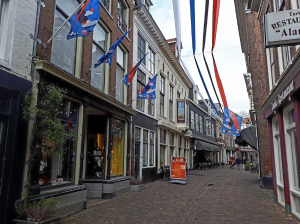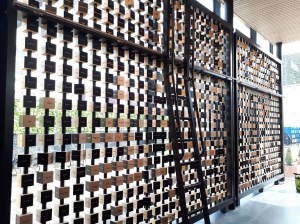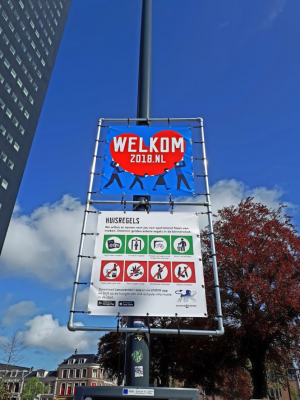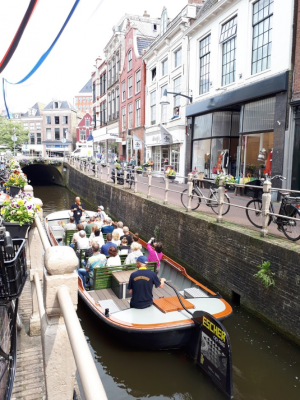European Capitals of Culture
The European Capitals of Culture (ECOC) project is one of the European Commission’s most recognized ones. The project started already in 1985, with the idea to put cities at the heart of cultural life in Europe. ECOC must incorporate economic and cultural objectives (O’Callaghan, 2012) and the offer of events should highlight the city’s own […]
The European Capitals of Culture (ECOC) project is one of the European Commission’s most recognized ones. The project started already in 1985, with the idea to put cities at the heart of cultural life in Europe. ECOC must incorporate economic and cultural objectives (O’Callaghan, 2012) and the offer of events should highlight the city’s own culture, as well as its place in European cultural heritage (European Council, 1999). Festivals and events are becoming very popular and can attract many visitors, this way possibly putting the city at the interest of people from all over Europe. As Herrero et al. (2006) mention, the ECOC project was first simply a cultural festival, but over the years, it transformed into a social, political and economic element at the local, national and European Union level. This year, Leeuwarden and Valleta are the two cities which can call themselves ‘Capitals of Culture’ of Europe.
The ECOC initiative from a historical viewpoint
Originally constituted in order to deal with economy-related issues at a European level, in the 1980s the European Community (EC) was confronted with an increasing deficiency of public support for the European project (Langen, cited in European Parliament, 2013). In this context, culture became apparent as one of the tools with potential to inspire identification with Europe and promote integration at the citizens’ level (Gold and Gold, cited in European Parliament, 2013). Against this background, in 1983, the Greek Minister of Culture Melina Mercouri suggested selecting a European city and denominating it the ‘Cultural City of Europe’, arguing for the importance of culture alongside trade and economics if the goal is to achieve European integration (European Parliament, 2013). Picked up in 1985 in the EC, this initial idea metamorphosed into the ECOC project.
Designed as a yearly event meant to connect people across 
The streets of Leeuwarden, celebrating that they are Capital of Culture. Source: Authors’ own picture.the Member States of the EC through culture, at the outset the initiative involved the selection of one European city each year to be awarded the title of ECOC. In the context of an insufficient and inappropriate legal basis, only cities in the 12 established Member States of the EC were initially given this designation, no competition between potential candidates being involved at this stage. Starting from 1997, however, well-defined selection criteria and bidding deadlines were put in place in order to ensure balance not only between capital and non-capital cities and between EU and non-EU cities, but also between Europe’s different geographical zones. Furthermore, while up to and including the year 1999 only one city per year bore the ECoC title, in the year 2000 all nine applicant cities have been granted the designation, in reflection of the ‘special significance of the year’ (European Parliament, 2013, p. 41) and creating a precedent for several following editions. For the period 2005-2019, new transformations in the legislative framework of the programme warranted that every Member State regularly had one of its cities conferred the title. What is more, each applicant city was requested to elaborate its nomination including a European dimension, i.e. an emphasis of both local cultural diversity and shared European cultural heritage (Lähdesmäki, 2014). Finally, with the growth of the European Union (EU), from 2009 onwards, two cities – initially, one from the established and one from the new Member States, and from 2010, from any European country including non-Member States – were assigned as ECOCs each year (European Parliament, 2013). As from 2021, every third year, a third city in a EU candidate or potential candidate country or in European Economic Area (EEA) country would be awarded the title (European Commission, 2018).
The ECOC initiative today: socio-cultural aspects

All European languages presented in this language exhibition. Can you find yours? Source: authors’ own picture.The ECOC project of the European Commission is nowadays one of the most famous cultural festivals at a European level (Steiner, Frey & Hotz, 2015). In our increasingly fragmented society, festivals respond to processes of cultural pluralisation, mobility and globalisation, while communicating meaning about identity and belonging (Bennett et al., 2014). This is exactly the reason ECOC organises festivals and events during Capital of Culture years, and such a year can also be considered a festival itself, with all its festivities. Culture plays an increasing role in festivals and cultural festivals are one of the most popular types nowadays (Liu, 2014; Ritzer, 1999; Urry, 2001). Culture can be seen as a specific way of life people have, related to for example clothing, religion, art and the entertainment a society (Lim, 1993; Volić et al., 2012), but usually, culture is understood as ‘artistic creativity’. Artistic creativity includes for example literature, music, visual arts and architecture (Volić et al., 2012). Cities have become stages for a stream of such cultural events, leading to ‘festivalization’ of these cities. Big cities are places of cultural production and centers of innovation, where cultural taste is being formed, for example through these events (Volić et al., 2012).
Events are often seen as spaces in time in which the visitor experiences the ‘extraordinary’, something that happens outside of his or her daily routine (Totschnig, 2017). Festivals and events have become new, alternative types of visitor attractions and staging events can be beneficial for host cities, to stimulate tourism and event demand, the city’s economy, by providing alternative sources of income, and in the case of cultural events, they can help preserving the culture. Cultural events reproduce past rituals and traditions (Liu, 2014; McCartney & Osti, 2007; Smith, 2003). This is also the case for Capitals of Culture, as they highlight the richness of European cultural diversity, but also give insights in shared history and heritage (European Commission, 2018). This way, the Capitals of Culture can stimulate mutual understanding (O’Callaghan, 2012). Further, such major cultural events can be very effective in boosting confidence and pride of local communities, possibly providing physical regeneration of citizens. However, this only happens when the events are perceived as authentic in essence. Only then, there can be a long-term successful and sustainable outcome (Liu, 2014).
In 2018, Leeuwarden is one of the Cultural Capitals. Leeuwarden’s concept of ‘iepen mienskip’, which means, 
Welcome sign close to the station, with all « house rules ». Source: Authors’ own picturetranslated from Frisian, ‘open community’, aims at strengthening and connecting communities from Leeuwarden, Friesland as a whole and also from everywhere in Europe (European Commission, 2018). As Leeuwarden-Friesland 2018, the name the organization gives itself, mentions on their promotion website, they feel like the world is getting bigger and the society more diverse (Leeuwarden-Friesland 2018, 2018). Examples of events are exhibitions in museums, in which art can be found, but it is also possible to learn more about development of the region through documentaries and photographs. Further, there are many possibilities for participating in a city tour with a guide or for exploring the city on your own, with the help of an app, which gives information about the surroundings. Also, throughout the whole city, there is art, which is especially designed for the Capital of Culture. It starts already walking for example out of the train station: the whole city celebrates being a Capital of Culture! Examples can be found on the images on this page.
The ECOC initiative today: economic impacts
It is undoubtedly the case that the ECOC has developed from a traditional cultural festival in the 1980s to an event of sizeable importance not only from a social, cultural and political viewpoint, but also from an economic perspective (European Parliament, 2013; Herrero et al., 2006). While ECOC cannot be called a mega-event in the same manner as the Olympic Games or the FIFA World Cup, the projects and cultural programming associated with it are certainly considerable in terms of economic costs and impacts (Theodoraki, 2014). All ECOC projects require extensive financial investments on behalf of the public authorities, with the budget for the cultural programme varying from €5.48m in Reykjavik 2000 to €58.6 million in Lille 2004 and the budget for capital expenditure from less than €10m in Bologna 2000 to more than €220 in Copenhagen 1996 and Thessaloniki 1997 (Steiner et al., 2015).
Festivals and events become increasingly popular means to showcase heritage and cultural resources, and thus, they are used to attract visitors to various destinations including cities. As a cultural festival of significant proportions, being conferred the title of ECOC is commonly associated with an improved city image not only in the eyes of the residents, but also in those of the tourists, any designation being usually accompanied by increases in visitor numbers and expenditures (Liu, 2014; Smith, 2003). In the same time, however, there are concerns that, rather than a means to display the local distinctiveness as well as its relation to the shared European heritage, cities seek tourist incomes and thus risk an over-commercialization of the event. The event transforms then in entertainment or spectacle, eventually destroying cultural authenticity (Getz, 1998; McCartney & Osti, 2007), and thereby the initial attraction as well (McCartney & Osti, 2007). According to Liu (2014), cultural tourists are increasingly searching for authentic experiences of ‘everyday culture’ in societies other than their own native, and are more and more likely to avoid commercial products, of which the ECOC can be an example.
In addition, starting with Glasgow in 1990, ECOC is not seen simply as a means to display a city’s cultural reserves, but also as an incentive for urban revitalization and revival of the
Tourists exploring the city on the water. Source: Authors’ own picture. local economy (Papanikolaou, 2012). Many of the former and future ECOCs invest heavily in the new provision and renovation of cultural assets such as museums and concert halls, of public spaces such as squares and gardens, as well as of infrastructure such as roads and railway stations. For example, in relation with its designation as ECOC 2018, the municipality of Leeuwarden-Ljouwert makes a long-term investment of €1 billion in cultural, traffic, tourist and city projects. Similarly, in the case of Porto 2001, significant transformations at the level of the public space, especially into what concerns city mobility, can be observed as part of the preparations for the ECOC year (Balsas, 2004).
ECOC: Heritagizing European culture
As a cultural event in itself and as a tool for displaying culture, Hristova (2017) highlights that the ECOC project is a suggestive example of efforts to heritagize European culture. Despite heritage not being an explicit priority at the outset, once with the introduction of the European dimension as one of the requirements for nomination, the ECOC has become an agent of heritagization bringing Europe’s heritage to the fore. Simultaneously, being one of the long-lasting programmes at a European level, with a history of already 33 years and counting, the initiative becomes a heritage asset in itself (i.e. the heritage of the European Community) albeit one in continuous metamorphosis.
Lauren Rae Joenoes
Roxana Mitroi
Bibliography
Balsas, C.J.L., City Centre Regeneration in the Context of the 2001 European Capital of Culture in Porto, Portugal, Local Economy, no. 19:4, 2004, 396-410 p.
Bennett, A., Taylor, J., Woodward, I. The Festivalization of Culture, Ashgate, Farnham, England, 2014.
Erfgoedissues, Welkom bij Erfgoedissues.nl!, https://www.erfgoedissues.nl/?_sp=06c8d6ec-cce4-491f-b87c- 7e7af7618c0.1519932680726
European Commission, European Capitals of Culture Factsheet, 2018.
European Council, Decision 1419/1999/EC of the European Parliament and of the Council of 25 May 1999, Official Journal of the European Union, 1999.
European Parliament, European Capitals of Culture: Success Strategies and Long-Term Effects, 2013.
Geelen, J.P., Opmerkelijke Advertentie – Het Onthullende en Spannende Verhaal, https://www.volkskrant.nl/opinie/ombudsblog-boze-reacties-op-het- nieuws-over-poging-tot-matchfixing-in-sotsji~a4557059/, 2018.
Getz, D. Event Tourism and the Authenticity Dilemma. In W. Theobold (Ed.), Global Tourism: Toward the Next Decade, no. 2. Oxford: Butterworth-Heinemann, 1998, 409-427 p.
Herrero, L.C., Sanz, J.A., Devesa, M., Bedate, A. and del Barrio, M.J., The Economic Impact of Cultural Events: A case-study of Salamanca 2002, European Capital of Culture, European Urban and Regional Studies, no. 13:1, 2006, 41-57 p.
Hinch, T.D. & De La Barre, K., Culture, Sport and Tourism: the Case of the Arctic Winter Games (Canada), in J.L.S. Highham (Ed.), Sport Tourism Destinations: Issues, Opportunities and Analysis, Oxford: Butterworth Heinemann, 2004, 260-273 p.
Hristova, S., The European Model of Cultural Heritage Policy, Cultural Heritage, Cultural Policy, no: 18:1, 2017, 1-16 p.
Lähdesmäki, T., Discourses of Europeanness in the reception of the European Capital of Culture events: The case of Pecs 2010, European Urban and Regional Studies, no. 21:2, 2014, 191-205 p.
Lim, H., Cultural Strategies for Revitalising the City: A Review and Evaluation, Regional Studies, no. 27:6, 1993, 589-595 p.
Liu, Y., Cultural Events and Cultural Tourism Development: Lessons from the European Capitals of Culture, European Planning Studies, no. 22:3, 2014, 498-514 p.
McCartney, G. & Osti, L., From Cultural Events to Sort Events: a Case Study of Cultural Authenticity in the Dragon Boat Races, Journal of Sport Tourism, no. 12:1, 2007, 25-40 p.
O’Callaghan, C.,. Urban Anxieties and Creative Tensions in the European Capital of Culture 2005: ‘It Couldn’t Just Be About Cork, Like’, International Journal of Cultural Policy, no.18:2, 2012, 185-204 p.
Papanikolaou, P., The European Capital of Culture: The Challenge for Urban Regeneration and Its Impact on the Cities, International Journal of Humanities and Social Science, no. 2:117, 2012, 268-273 p.
Ritzer, G., Enchanting a Disenchanted World: Revolutionizing the Means of Consumption, Thousand Oaks, CA: Pine Forge Press, 1999.
Smith, M.K.,. Issues in Cultural Tourism Studies, London: Routledge, 2003.
Steiner, L., Frey, B. and Hotz, S., European Capitals of Culture and life satisfaction, Urban Issues, no. 52:2, 2015, 374-394 p.
The Heritage Council, What Is Heritage? http://www.heritagecouncil.ie/what-is-heritage, n.d.
Theodoraki, E., Evaluation and Legacy of the ECOC: Event Ownvers’ and Event Hosts’ perspectives, Economia della cultura, no. 2, 2014, 183-193 p.
Totschnig, W.,. What is an Event? Probing the Ordinary/Extraordinary Distinction in Recent European Philosophy, Constellations, no. 24:1, 2017.
Umass, What Is Heritage?, https://www.umass.edu/chs/about/whatisheritage.html, n.d.
Urry, J., The Tourist Gaze, London: Sage, no. 2, 2001.
Volić, I., Bajić, L., Radenković-Šošić, B., Belgrade as European Capital of Culture – Conceptual Conjunction, Spatium International review, no. 27, 2012, 26-30 p.


 Université Jean Monnet
Université Jean Monnet